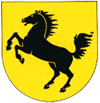| |
The roots
of Stuttgart date back to the 10th century. In those days, Stuttgart,
named Stutengarten, was a stud farm for Herzog Luidolf's horses.
Therefore, Stuttgart takes its name and its coat of arms from this
stud farm.
The earliest dated records of "Stuotgarten" are from the
year 1229. In the 13th century, Stuttgart obtained its city status.
Stuttgart was an unknown settlement until the 14th century, when
the Count of Württemberg took up residency in The
Old Palace, located in Stuttgart.
However, it wasn't until 1488 that Stuttgart became the official
capital and residence of Count Eberhard. The next century, in which
Stuttgart was in the hands of Austria for a short time, was characterized
by political and scientific unrest. Throughout history, the City
of Stuttgart was often tested, especially during the 30 Years War.
The annual People's Fair was first celebrated in 1818 when King Wilhelm
organized the fair for the citizens of Stuttgart.
During the first half of the 19th century, the history of Stuttgart
changed. Stuttgart became more of an industrial region, instead
of the regal region it had been. Men like Gottlieb Daimler and Robert
Bosch started a new era in the history of technology and changed
the history of Stuttgart.
During the Second World War, Stuttgart was heavily damaged by several
air raids. The buildings were quickly restored after the war, and
Stuttgart became the Capital of Baden-Württemberg in 1952.
|
|
| |

Stuttgart's Coat of Arms
|
|

